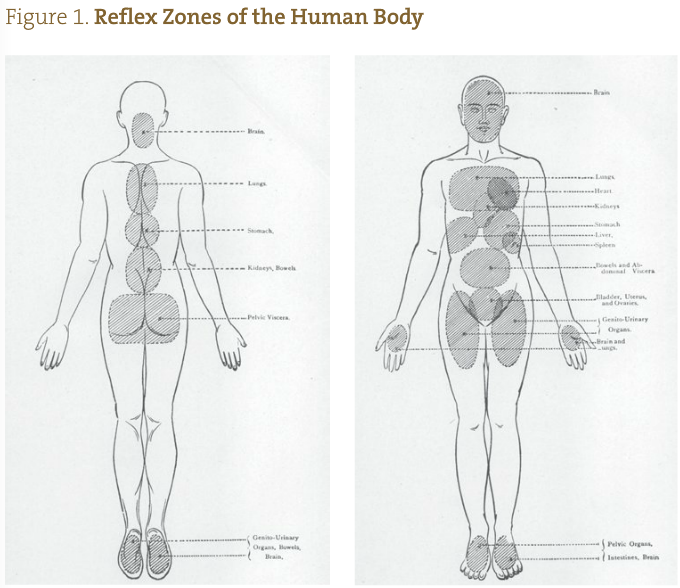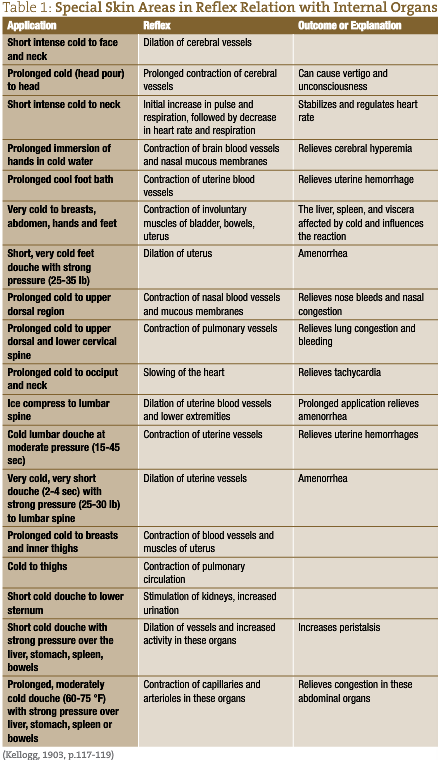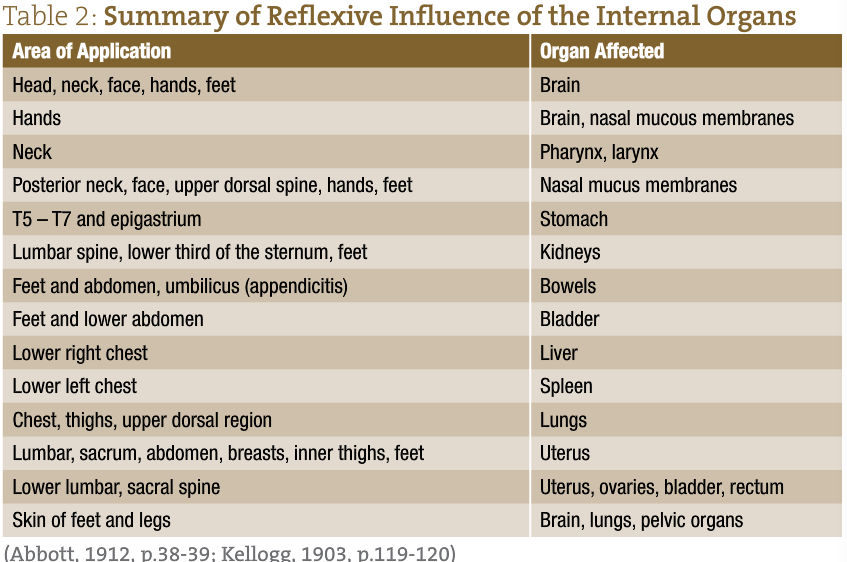Nature Cure Clinical Pearls: Reflexes
Sussanna Czeranko, ND, BBE
In fact, we venture to claim that in the blood vessels of the skin and underlying tissues we have in the higher vertebrates, just as found everywhere in the lower forms of life, a great ‘skin heart,’ which plays an important part in the circulation, not only in health but also in disease.
-Simon Baruch, 1898, p.10A cold compress applied to the spine or abdomen, or a cold full bath caused instant dilation of the cerebral vessels, lasting from 3 to 10 minutes, then giving place to contraction.
-John Harvey Kellogg, 1903, p.115It is because of the reflex action that clinicians utilize dermal thermic applications for the production of special changes in the circulation, and by these means endow the different organs with increased and active function.
-Curran Pope, 1909, p.30
The early naturopaths used water as one of their chief therapeutic tools and not because they did not have today’s choices in nutraceuticals, nor that they were they stuck with limited options. The literature of the period shows repeatedly that they had abundant options, with more being developed and utilized all the time. Rather, they loved water because it provided a therapy that was natural, effective, and reliable. Their knowledge of water’s therapeutic properties was a great strength of these early naturopaths. Let us explore a small segment of that expertise by taking a closer look at the hydriatric concept of reflexes.When a patient presents with symptoms accompanied by suffering, whether it be visceral, emotional, or both, as clinicians trained well in diagnostics, we often are very sensitive to the personal dimensions, the more holistic expression of the patient’s story. Even as we listen and watch closely for physiological, symptomatic, and contextual detail to help us hear and understand that story, our beginning point is recognizing that somewhere inside that patient’s body, something is not working right. All our instincts focus on finding out the what and the why. We are guided by our clinical experience, of course, and by the underlying principle of doing no harm. Our repertoire of therapeutic tools is a gentle one and a powerful one. Take water, for example.
Given that their objective – like ours to this day – is to alleviate discomfort without doing harm, the early naturopaths often considered water-cure treatments. Simon Baruch, for example, although not a naturopath himself, but most certainly allied with the emerging profession on the subject of “do no harm,” felt strongly that when doctors understood the rationale of the action underlying hydrotherapy, that understanding would “lead the practitioner to the adoption of hydriatric methods in all those conditions in which they are therapeutically superior to medicinal agents or in which they may become auxiliaries to the latter.” (Baruch, 1892, p.29-30) Baruch explains, “Medicinal agents are, as every experienced physician knows, utterly impotent in such cases to endow organs suffering from languid blood supply with vigor by the increased afflux of blood and heat and nerve force.” (Baruch, 1892, p.42) Baruch observed that water was fully capable of achieving what drugs could not. He continues, “This may be accomplished readily by the restrostasis which invariably results when blood is driven from one part of the body into another, not by severe local irritants, blisters, cautery, etc., but by processes which imitate the physiological closely, and which are under complete control of the hydrotherapeutist.” (Baruch, 1892, p.42)
The Reflexes
The application of cold and hot on the skin affects organs, muscles, lymphatic and blood circulation, blood constituents, blood pressure, heart function, respiration, digestion, secretions, absorption, and temperature. In essence, the whole body comes under the influence of these hydro measures. To understand how water applied to the surface of the body can have such profound effects, one comes to the notion of reflexes. What is meant by reflexes? In one of the earliest writings by Simon Baruch, we get an early indication of what he meant by “reflex.” He contended that “reflex” implied that vasomotor effects were implicated in the changes to distribution of blood from water applications. (Baruch, 1898, p.30)
George Abbott adds to this discussion of the physiological basis of the reflex theory. He writes, “These efferent (outgoing) sympathetic nerves are connected not only with the blood vessels of the internal organs, but also with their muscles and glands. Because of these connections, every function of the body may be stimulated or depressed by influences arising in the skin.” (Abbott, 1912, p.37) Hinsdale states, “On applying hot or cold to the skin, there is a direct influence on the part, but indirectly and reflexly through the central nervous system there are far-reaching effects upon the circulation in distant parts.” (Hinsdale, 1910, p.25) Pope weighs in: “Temperature, nerve and vascular effects are closely allied, and, as in heat production, so in blood vascular circulation, cold enhances the tone of the blood vessel wall, while heat lowers it, although both may be followed by vascular dilation, in the one instance tonic (cold), in the other atonic (heat).” (Pope, 1909, p.30)
More than a century ago, the scientific exploration of hydriatric applications on the various systems of the body also included animal experimentation to observe the effects created when cutaneous sensory nerves were stimulated by various temperatures of water. It is common sense that if cold is applied to one part of the body, then in its immediate vicinity certain changes would occur. For example, applying any kind of cold to the skin will blanche the area, and shriveling will occur in the form of goose bumps. Baruch offers an explanation: “This is due to contraction of the circular fibres of the cutaneous vessels, or, in the case of the finer capillaries, of the muscular fibres existing in the skin, by which the blood is driven out.” (Baruch, 1898, p.35-36)
The Skin Heart
The enduring dedication of our early naturopaths to water makes it easy for us to understand why they were so enamored with hydrotherapy for many purposes. They knew that applications made to the skin surface of the body could modify the internal environment back toward health. Cold water was preferred over hot, although each had its place in therapeutics, such as in effects on blood circulation. Blood circulation related to the skin had a huge impact on the entire circulatory system. In this regard, Pope called the skin a vascular organ and notes that “the skin [is] one of the most richly supplied of the organs with small blood vessels, especially capillaries.” (Pope, 1909, p.18) Baruch also attributed great importance to the skin. He wrote, “The great contractile mesh of the cutaneous vessels is capable of containing over 30% of the entire blood of the body, and that the whole of this surface is affected by the cold bath, it hardly seems impossible that the stimulation of this great diffuse ‘skin heart’ may be a factor of the greatest importance in improving the entire circulation.” (Baruch, 1898, p.11) Pope adds, “The muscular and cutaneous surfaces are capable of controlling and holding approximately 60% of the entire blood of the body.” (Pope, 1909, p.18)
We cannot forget that the skin as a sensory organ and its “nerve endings terminating upon the surface of the skin, serve the purpose of bringing the human organism into contact with, or conscious of, the external world.” (Pope, 1909, p.15) Pope elaborates, “The intimate association of the skin with the cerebro-spinal and sympathetic systems of nerves makes the skin an organ capable of producing the profoundest reflex influences upon distant organs and functions, and, as it is constantly exposed to varying conditions of irritation, so does it produce varying influences upon different portions of the body by means of its referred and reflex action.” (Pope, 1909, p.15)
Building on this knowledge of the therapeutic uses of water and the miraculous agility and responsiveness of the skin, we can continue our discussion of reflexes. Our early forebears also understood nerve stimulation and its definite effects on the organ systems of the body. Cold wet stimulation of skin not only affected the organs and tissues along the connected nerve pathway, but also the blood vessels, and muscles. Kellogg states, “It becomes apparent that to produce reflex effects in the muscles we have but to make cold applications to those areas the stimulation of which is capable of developing muscular contraction.” (Kellogg, 1903, p.117) For example, to activate the muscles and internal organs, there were 5 main regions used to induce a therapeutic response. These included: intrascapular region, epigastrium, abdomen, cremasteric (inner and upper surface of the thigh), and plantar surface of the feet. (Kellogg, 1903, p.117)
The concept of reflex points on the body corresponding to the organs was recognized early on by Simon Baruch. Baruch cited Naumann, a scientist who first “demonstrated clearly that the effects of external irritants upon the circulation within the body are really reflex.” (Baruch, 1898, p.33) Baruch acknowledges, “Thermic irritants induce changes of innervation not only at the point of contact, but also in sensory tracts, in the nerve centres, and in all motor and trophic fibres connected with them whenever they fall within the sphere of irritation, either by transmitted or reflex action.” (Baruch, 1892, p.34) Baruch was also influenced by the work of Wilhelm Winternitz, who in turn was considered the father of scientific hydrotherapy. Winternitz ardently researched in the 19th century, unraveling the scientific basis of hydrotherapy. Kellogg also was impressed with Winternitz’s work. He comments, “The experiments of Winternitz, and later those of Franck, showed … that cold applied to one hand causes contraction of the vessels in the other hand.” (Kellogg, 1903, p.116) Cold applications locally or distally had reflex effects upon the body.
Kellogg also cites research conducted in 1893 by Wertheimer, who demonstrated that cold acts in accordance to the “general law relating to the reflex influence of peripheral irritants.” (Kellogg, 1903, p.102) He continues, “Short and intense applications cause a brief preliminary contraction of the vessels of the internal viscera, which is quickly followed by dilation of the same; while a prolonged, more moderate application of cold to the surface results in a renewed and prolonged contraction of the small vessels in the internal regions of the body.” (Kellogg, 1903, p.102) This contraction helps the body to preserve the loss of heat and prevent injury.
The Dive Reflex
Kellogg refined Baruch’s work, but we must credit Baruch for his scientific mind in search of precision. Baruch distinguishes reflex activity having multiple pathways other than stimulation of the motor nerves upon the higher nerve pathways to the brain. He continues, “There are everywhere numerous networks of ganglia, which may perform the function of nerve centres within the immediate sphere without depending upon impulses from the brain or spinal cord.” (Baruch, 1892, p.34) A well-known principle called “the dive reflex” is a complex cardiovascular-respiratory response to immersion. This multi-reflex response in animals consists of apnea; bradycardia; peripheral vasoconstriction (resulting in preferential perfusion of the brain and heart); decreased cardiac output (with a maintained or increased stroke volume); and an increase in mean arterial blood pressure. These cardiovascular alterations act in a manner that conserves oxygen for the heart and brain.” (Wittmers et al., 1987, p.1031) A simple, cold, wet compress is sufficient to induce the effects of facial immersion found in the dive reflex, such as bradycardia and peripheral vasoconstriction. In 1892, Baruch comments on this reflex: “Whoever has witnessed the revivification of a fainting person by a dash of cold water, how the color returns to the pallid cheek, how the glazed eyes brighten and consciousness returns, must be convinced that only through impressions upon the sensory nerve endings, conveyed to the nerve centres, could such rapid and positive effects be initiated.” (Baruch, 1892, p.35)
Baruch’s writings influenced all hydrotherapists and water-cure therapists from both sides of medicine. This growing body of knowledge was taken into account by the early hydrotherapists in understanding how to use water for the treatment of disease. The early pioneers include Simon Baruch and particularly John Harvey Kellogg, who studied and laboriously documented the effects of water applications on the skin and their corresponding reactions internally. Kellogg catalogued the body, compiled into a chart for easy reference (see Tables 1 and 2). Kellogg left behind a schematic visual map of the human body with the associated reflex zones and the parts they affected (Figure 1). These diagrams were adopted by other hydrotherapists who followed in the steps of Kellogg. These diagrams became the essential guiding map.
Kellogg summarizes the reflex action to be expected with the application of short and intense, or prolonged and moderate, cold applications to the skin. He defines, “the application is short and intense (1 to 4 sec), temperature 40° to 60° F., pressure 25 to 35 lbs. (dilation), or long and moderate [60 to 75 °F] (contraction).” (Kellogg, 1903, p.119)
An example of reflexes can be seen in a cold foot bath. Kellogg reminds us, “The sole of the foot is one of the most important basal motor areas in the body, having very direct connection with the nerve centers which control the circulation of the pelvic and abdominal viscera.” (Kellogg, 1903, p.753) He continues, “The brain circulation may also be influenced by stimulation of the basal motor nerve supply of the plantar region.” (Kellogg, 1903, p.753) We can readily see that a simple cold foot bath can influence digestive and reproductive organs, and even the brain.
The revulsive effect of a cold foot bath can remarkably reduce uterine congestion, intestinal peristalsis, and uterine hemorrhage. By a simple, indirect cold water bath, the naturopath can influence positively these major organs without harmful effects.


 Sussanna Czeranko ND, BBE, incorporates “nature-cure” approaches to primary care by including balneotherapy, breathing therapy, and nutrition into her naturopathic practice. Dr Czeranko is a faculty member working as the Rare Books curator at NCNM and is currently compiling a 12-volume series based upon the journals published early in the last century by Benedict Lust. Four of the books have been published: Origins of Naturopathic Medicine, Philosophy of Naturopathic Medicine, Dietetics of Naturopathic Medicine, and Principles of Naturopathic Medicine. In addition to her work in balneotherapy, she is the founder of the Breathing Academy, a training institute for naturopaths to incorporate a scientific model of breathing therapy called Buteyko into their practice. She is a founding board member of the International Congress of Naturopathic Medicine and a member of the International Society of Medical Hydrology.
Sussanna Czeranko ND, BBE, incorporates “nature-cure” approaches to primary care by including balneotherapy, breathing therapy, and nutrition into her naturopathic practice. Dr Czeranko is a faculty member working as the Rare Books curator at NCNM and is currently compiling a 12-volume series based upon the journals published early in the last century by Benedict Lust. Four of the books have been published: Origins of Naturopathic Medicine, Philosophy of Naturopathic Medicine, Dietetics of Naturopathic Medicine, and Principles of Naturopathic Medicine. In addition to her work in balneotherapy, she is the founder of the Breathing Academy, a training institute for naturopaths to incorporate a scientific model of breathing therapy called Buteyko into their practice. She is a founding board member of the International Congress of Naturopathic Medicine and a member of the International Society of Medical Hydrology.
References
- Abbott, G. K. (1912). Elements of Hydrotherapy for Nurses. Washington, DC: Review and Herald Publishing Association; 275 pp.
- Baruch, S. (1892). The Uses of Water. Detroit, MI: George S. Davis Publisher; 228 pp.
- Baruch, S. (1898). The Principles and Practice of Hydrotherapy. New York, NY: William Wood and Company; 435 pp.
- Hinsdale, G. (1910). Hydrotherapy. Philadelphia, PA: W. B. Saunders Company; 466 pp.
- Kellogg, J. H. (1903). Rational Hydrotherapy. Philadelphia, PA: F. A. Davis Company Publishers; 1193 pp.
- Pope, C. (1909). Practical Hydrotherapy. Cincinnati, OH: Cincinnati Medical Book Company; 646 pp.
- Wittmers, L.E., Jr, Pozos, R. S., Fall, G., & Beck, L. (1987). Cardiovascular responses to face immersion (the diving reflex) in human beings after alcohol consumption. Ann Emerg Med. 16(9), 1031-1036.










